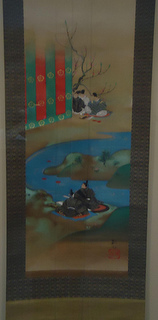
One of a set of hanging scrolls depicting the gosekku, by Ikeda Koson, c. 1830. Freer Gallery of Art.
- Japanese: 五節句 (gosekku)
The gosekku (lit. "five seasonal festivals") were five of the most important seasonal rites performed by the Imperial Court.
They consist of:
- Jinjitsu no sekku - 1st month, 7th day, seven herbs were eaten. Also known as Nanakusa no sekku, Wakana no sekku. In the Imperial Court, this was accompanied by a rite called Kochôhai.
- Jômi no sekku or Jôshi - 3/3, Girls' Festival, Dolls Festival, aka Hina matsuri. Also celebrated as the Kyokusui festival, emulating the famous Orchid Pavilion gathering organized by Wang Xizhi in 353. In emulation of that event, courtiers composed poetry while floating wine cups down a stream in one of the palace gardens.
- Tango no sekku - 5/5 Boys' Festival, aka Kodomo no hi. Celebrated in the Court as an iris festival.
- Tanabata - 7/7 The festival of the Weaver Star. Called Kikkoden in the Court.
- Chôyô no sekku - 9/9, Chrysanthemum Festival. A festival in connection with the rice harvest, and related to one in China which involved the drinking of chrysanthemum wine.
During the Tokugawa period, the first, 15th, and 28th days of each month were also ceremonial days, as were Kashô, observed on 6/6, and Hassaku, observed on 8/1.[1]
References
- Arai Hakuseki, Joyce Ackroyd (trans.), Told Round a Brushwood Fire, University of Tokyo Press (1979), 286n122.
- Gallery label, Freer Gallery of Art, "Gosekku: The Five Ancient Festivals of the Imperial Court," Ikeda Koson, set of five hanging scrolls, c. 1830, F1999.5.1a-f.
- ↑ Edojô 江戸城, Tokyo: Gakushu Kenkyusha (1995), 120.